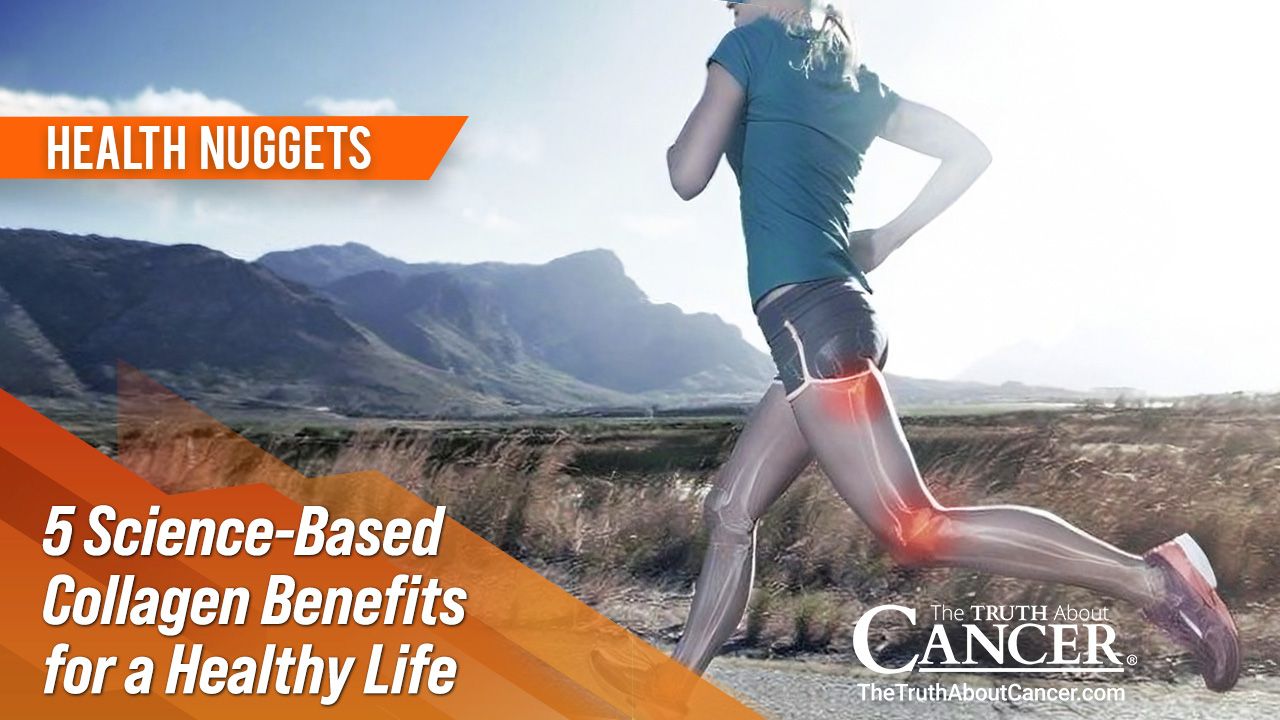Top Benefits of Taking Collagen Supplements
#healthbenefits #collagen #bonehealth #immunehealth #wellness
People
Circles
Posts
The Truth About Cancer: Health Nugget 90 - 5 Science-Based Collagen Benefits for a Healthy Life
https://www.brighteon.com/fd274d18-19d7-46cf-a51e-f0d8a460939d

Discover the transformative power of collagen. Unveil the science behind collagen's role as the body's essential protein, delving into its functions from fortifying joints to revitalizing skin elasticity. Learn how aging impacts collagen production and explore the myriad benefits of incorporating collagen supplements into your daily regimen, from reducing joint pain to promoting hair growth. Unlock the secrets to radiant skin, stronger bones, and enhanced overall well-being with collagen—a holistic approach to aging gracefully and thriving from the inside out.-----------------------------------------------------------------------------------------------------------------------------Ty & Charlene Bollinger are the Founders of The Truth About Cancer and The Truth About Vaccines. They are Christians, proud parents of four children, business owners and Health Freedom Activists. Charlene recently started a toxic free, luxury skincare line of perfect skincare products - CHARLIS. Charlene & Ty just launched the World Premiere of their latest 9 episode documentary series, Propaganda EXPOSED! [UNCENSORED]. Together they are proud members of the "Disinformation Dozen" risking everything to bring the truth about cancer, vaccines, and real medicine, that saves countless lives into the world, for you.Ty and Charlene have been on this mission together to reach as many people around the world with the truth that saves lives as they can and they need your help! As you know they are being censored with many other truth tellers.Please support their mission by sharing this video! Next, you can support them by going to www.thetruthaboutcancer.com and signing up for their FREE Newsletter!Also, join Ty & Charlene on Alt Social Media platforms where the TRUTH is allowed and join the discussion thereFollow, Subscribe, & SHARE:1. Telegram: https://t.me/TheTruthAboutCancer_Vaccines 2. GAB: https://gab.com/TyCharleneBollinger 3. GETTR: https://gettr.com/user/cancertruth 4. TruthSocial: https://truthsocial.com/@TheTruthAboutCancer 5. CloutHub: https://app.clouthub.com/#/users/u/TheTruthAboutCancer 6. Bitchute: https://www.bitchute.com/channel/vX3lcHH4Dvp0/ 7. Rumble: https://rumble.com/c/TheTruthAboutCancerOfficial 8. Brighteon: https://www.brighteon.com/channels/thetruthaboutcancer
www.brighteon.com
Ensure you are getting the finest lab-verified collagen peptides today
https://bit.ly/3vZMXYx
#wellness #supplement #healthbenefits #healthyliving #immunehealth #skinhealth
Videos
People
Circles
Videos
Posts
Top Benefits of Taking Collagen Supplements
#healthbenefits #collagen #bonehealth #immunehealth #wellness
The Truth About Cancer: Health Nugget 90 - 5 Science-Based Collagen Benefits for a Healthy Life
https://www.brighteon.com/fd274d18-19d7-46cf-a51e-f0d8a460939d

Discover the transformative power of collagen. Unveil the science behind collagen's role as the body's essential protein, delving into its functions from fortifying joints to revitalizing skin elasticity. Learn how aging impacts collagen production and explore the myriad benefits of incorporating collagen supplements into your daily regimen, from reducing joint pain to promoting hair growth. Unlock the secrets to radiant skin, stronger bones, and enhanced overall well-being with collagen—a holistic approach to aging gracefully and thriving from the inside out.-----------------------------------------------------------------------------------------------------------------------------Ty & Charlene Bollinger are the Founders of The Truth About Cancer and The Truth About Vaccines. They are Christians, proud parents of four children, business owners and Health Freedom Activists. Charlene recently started a toxic free, luxury skincare line of perfect skincare products - CHARLIS. Charlene & Ty just launched the World Premiere of their latest 9 episode documentary series, Propaganda EXPOSED! [UNCENSORED]. Together they are proud members of the "Disinformation Dozen" risking everything to bring the truth about cancer, vaccines, and real medicine, that saves countless lives into the world, for you.Ty and Charlene have been on this mission together to reach as many people around the world with the truth that saves lives as they can and they need your help! As you know they are being censored with many other truth tellers.Please support their mission by sharing this video! Next, you can support them by going to www.thetruthaboutcancer.com and signing up for their FREE Newsletter!Also, join Ty & Charlene on Alt Social Media platforms where the TRUTH is allowed and join the discussion thereFollow, Subscribe, & SHARE:1. Telegram: https://t.me/TheTruthAboutCancer_Vaccines 2. GAB: https://gab.com/TyCharleneBollinger 3. GETTR: https://gettr.com/user/cancertruth 4. TruthSocial: https://truthsocial.com/@TheTruthAboutCancer 5. CloutHub: https://app.clouthub.com/#/users/u/TheTruthAboutCancer 6. Bitchute: https://www.bitchute.com/channel/vX3lcHH4Dvp0/ 7. Rumble: https://rumble.com/c/TheTruthAboutCancerOfficial 8. Brighteon: https://www.brighteon.com/channels/thetruthaboutcancer
www.brighteon.com
Ensure you are getting the finest lab-verified collagen peptides today
https://bit.ly/3vZMXYx
#wellness #supplement #healthbenefits #healthyliving #immunehealth #skinhealth
Ensure you are getting the finest lab-verified collagen peptides today
https://bit.ly/3vZMXYx
#wellness #supplement #healthbenefits #healthyliving #immunehealth #skinhealth
Tuesday, April 9th, 2024
McConnell Cannot Stop the Non-Interventionist Tide
Ron Paul, MD
The Labor Market’s Not Strong, The Fed’s Completely Wrong
David Stockman
Why Do Ambulances Now Post Warning Signs of Sepsis, Not Covid-19?
Wayne Lusvardi
In Praise of Paper and Ink
Restoring Truth
The Mechanism: How the ‘Order’ Based on Made-up Rules Is Descending Into Savagery
Pepe Escobar
NATO: It’s Time To Cull the Snake in the US’s Garden
Tom Luongo
The Inmates Are Running the American Foreign Policy Asylum
Joseph Sansone, PhD
‘Quaint and Obsolete?’
Karen J. Greenberg
The Total Tipping Point Also Involves a Cold War!
Brandon Campbell
America Has a Third World Economy
Paul Craig Roberts
Gaza: What If America Were the Good Guy?
Ilana Mercer
The Ultimate Guide to Bone Broth: Nature’s Collagen Supplement
Dr. Joseph Mercola
https://www.lewrockwell.com






